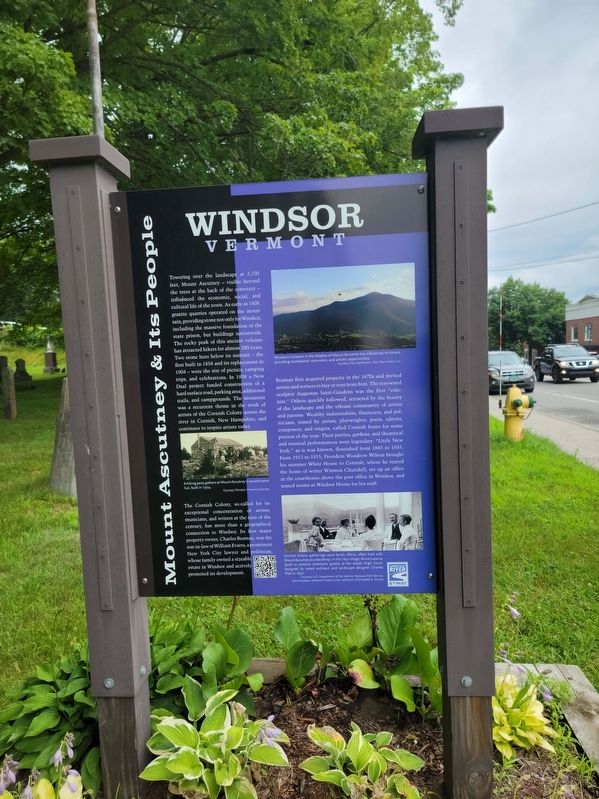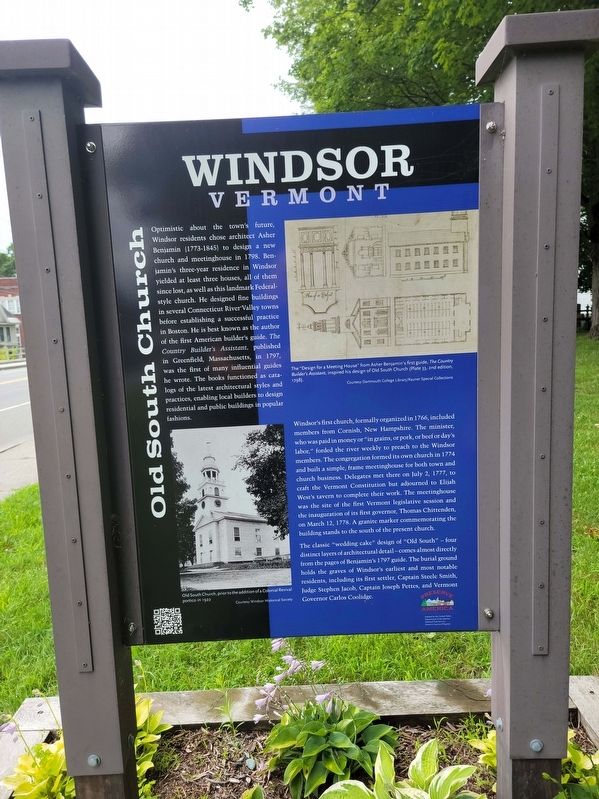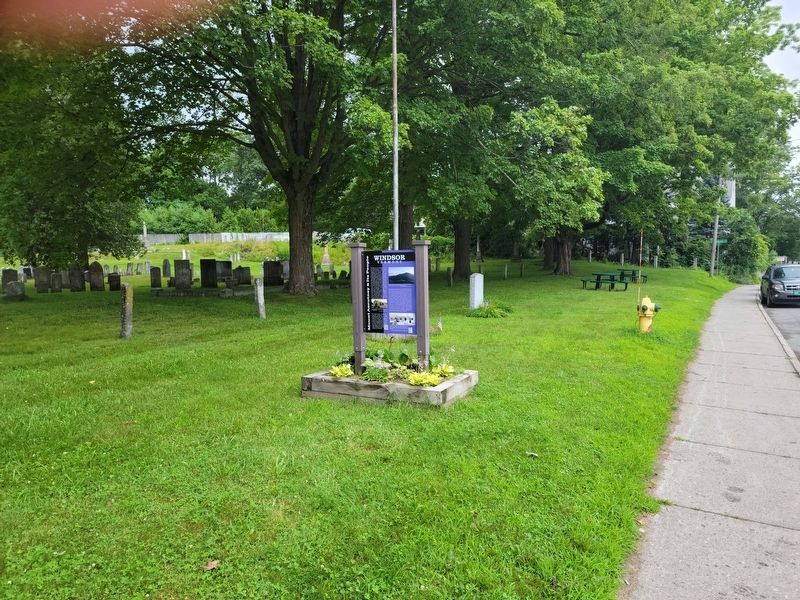Windsor in Windsor County, Vermont — The American Northeast (New England)
Mount Ascutney & Its People / Old South Church
Windsor Vermont
Mount Ascutney & Its People
Towering over the landscape at 3,150 feet, Mount Ascutney — visible beyond the trees at the back of the cemetery — influenced the economic, social, and cultural life of the town. As early as 1808, granite quarries operated on the mountain, providing stone not only for Windsor, including the massive foundation of the state prison, but buildings nationwide. The rocky peak of this ancient volcano has attracted hikers for almost 200 years. Two stone huts below its summit — the first built in 1858 and its replacement in 1904 — were the site of picnics, camping trips, and celebrations. In 1938 a New Deal project funded construction of a hard surface road, parking area, additional trails, and campgrounds. The mountain was a recurrent theme in the work of artists of the Cornish Colony across the river in Cornish, New Hampshire, and continues to inspire artists today.
The Cornish Colony, so-called for its exceptional concentration of artists, musicians, and writers at the turn of the century, has more than a geographical connection to Windsor. Its first major property owner, Charles Beaman, was the son-in-law of William Evarts, a prominent New York City lawyer and politician, whose family owned a sizeable estate in Windsor and actively promoted its development.
Beaman first acquired property in the 1870s and invited artists and writers to buy or rent from him. The renowned sculptor Augustus Saint-Gaudens was the first “colonist.” Others quickly followed, attracted by the beauty of the landscape and the vibrant community of artists and patrons. Wealthy industrialists, financiers, and politicians, joined by artists, playwrights, poets, editors, composers, and singers, called Cornish home for some portion of the year. Their parties, gardens, and theatrical and musical performances were legendary. “Little New York,” as it was known, flourished from 1885 to 1935. From 1913 to 1915, President Woodrow Wilson brought his summer White House to Cornish, where he rented the home of writer Winston Churchill, set up an office in the courthouse above the post office in Windsor, and rented rooms at Windsor House for his staff.
( photo captions )
A hiking party gathers at Mount Ascutney’s second stone hut, built in 1904. Courtesy Windsor Historical Society
Windsor’s location in the shadow of Mount Ascutney has influenced its history, providing recreational, economic, and artistic opportunities. Courtesy Paul Sanderson, Our Town Films, Inc.
Cornish Colony gatherings were lavish affairs, often held with Mount Ascutney as a backdrop. In this 1892 image, Annie Lazarus (back to camera) entertains guests at her estate High Court, designed by noted architect and landscape designer Charles Platt in 1890. Courtesy U.S. Department of the Interior, National Park Service, Saint-Gaudens National Historic Site, Collection of Elizabeth E. Gunter
Old South Church
Optimistic about the town’s future, Windsor residents chose architect Asher Benjamin (1773-1845) to design a new church and meetinghouse in 1798. Benjamin’s three-year residence in Windsor yielded at least three houses, all of them since lost, as well as this landmark Federal-style church. He designed fine buildings in several Connecticut River Valley towns before establishing a successful practice in Boston. He is best known as the author of the first American builder’s guide. The Country Builder’s Assistant, published in Greenfield, Massachusetts, in 1797, was the first of many influential guides he wrote. The books functioned as catalogs of the latest architectural styles and practices, enabling local builders to design residential and public buildings in popular fashions.
Windsor’s first church, formally organized in 1766, included members from Cornish, New Hampshire. The minister, who was paid in money or “in grains, or pork, or beef or day’s labor,” forded the river weekly to preach to the Windsor members. the congregation formed its own church in 1774 and built a simple, frame meetinghouse for both town and church business. Delegates met there on July 2, 1777, to craft the Vermont Constitution but adjourned to Elijah West’s tavern to complete their work. The meetinghouse was the site of the first Vermont legislative session and the inauguration of its first governor, Thomas Chittenden, on March 12, 1778. A granite marker commemorating the building stands to the south of the present church.
The classic “wedding cake” design of “Old South” — four distinct layers of architectural detail — comes almost directly from the pages of Benjamin’s 1797 guide. The burial ground holds the graves of Windsor’s earliest and most notable residents, including its first settler, Captain Steele Smith, Judge Stephen Jacob, Captain Joseph Pettes, and Vermont Governor Carlos Coolidge.
( photo captions )
The “Design for a Meeting House” from Asher Benjamin’s first guide, The Country Builder’s Assistant, inspired his design of Old South Church (Plate 33, 2nd edition, 1798). Courtesy Dartmouth College Library/Rauner Special Collections
Old South Church, prior to the addition of a Colonial Revival portico in 1922 Courtesy Windsor Historical Society
Topics. This historical marker is listed in these topic lists: Churches & Religion • Settlements & Settlers. A significant historical date for this entry is March 12, 1778.
Location. 43° 28.692′ N, 72° 23.251′ W. Marker is in Windsor, Vermont, in Windsor County. Marker is on Main Street (U.S. 5) south of River Street, on the right when traveling south. Located in front of the Old South Church Cemetery. Touch for map. Marker is in this post office area: Windsor VT 05089, United States of America. Touch for directions.
Other nearby markers. At least 8 other markers are within walking distance of this marker. Windsor Veterans Monument (here, next to this marker); Windsor’s First Meeting House (a few steps from this marker); Windsor Veterans Memorial (a few steps from this marker); Windsor Gulf War Honor Roll (about 800 feet away, measured in a direct line); Original Site of Constitution House (about 800 feet away); Windsor Vietnam War Memorial (about 800 feet away); Windsor Korean Conflict Honor Roll (about 800 feet away); Windsor World War II Honor Roll (approx. 0.2 miles away). Touch for a list and map of all markers in Windsor.
Also see . . .
1. Town of Windsor, Vermont. (Submitted on August 30, 2021, by Michael Herrick of Southbury, Connecticut.)
2. Windsor, Vermont (Wikipedia). (Submitted on August 30, 2021, by Michael Herrick of Southbury, Connecticut.)
Credits. This page was last revised on August 1, 2023. It was originally submitted on August 30, 2021, by Michael Herrick of Southbury, Connecticut. This page has been viewed 195 times since then and 33 times this year. Photos: 1, 2, 3. submitted on August 30, 2021, by Michael Herrick of Southbury, Connecticut.


